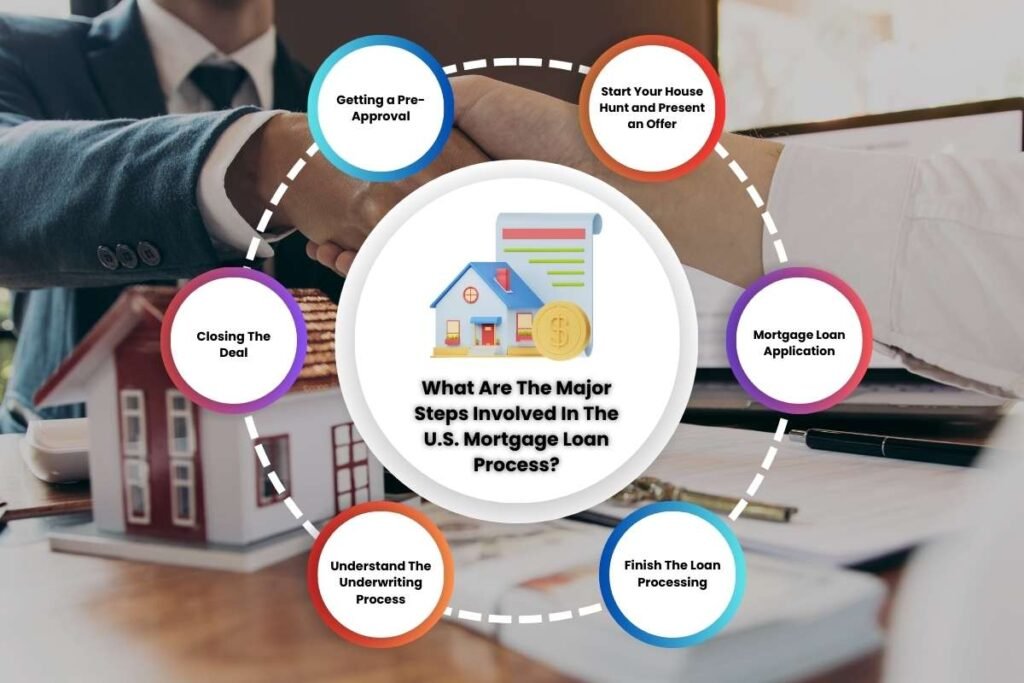Managing finance is among the daunting responsibilities to endure in adulthood. We do have certain final goals that justify the term of settling down in life. That final to-do list includes buying a house. In the given economic structure where the cost of living increased, looking for a home has become tiring. The United States has seen a boom in the real estate business, and buying a home in that marketplace is not easy.
Are you planning to buy a perfect home? Well, the process involved might be exhausting, but the basic level includes mortgage loans. This blog will help you understand each step of the U.S. mortgage loan process and ensure that your deal goes smoothly.
What You Need To Know About a Mortgage Loan
When you’re looking to buy a home, plot of land, or any other real estate, a mortgage is how you’ll secure the funds. Essentially, it’s a loan that you agree to pay back over time, usually through regular payments that cover both the principal (the amount you borrowed) and the interest. As part of this agreement, the property you’re buying acts as collateral to ensure the lender is protected if you can’t make the payments.
To get a mortgage, you’ll first need to apply with your chosen lender. As part of the process, the lender will check that you meet specific criteria, such as having a minimum credit score and enough money for a down payment. After applying, your mortgage application will go through a detailed underwriting process, where the lender will review your financial situation before moving forward. Keep in mind that there are different types of mortgages to choose from, like conventional or fixed-rate loans, so it’s important to select one that fits your financial needs and goals.
What Are The Major Steps Involved In The U.S. Mortgage Loan Process?

Now that you have an understanding of what these loans are let us discuss the major steps involved in the U.S. mortgage loan process.
1. Getting a Pre-Approval
Even before you start your house-hunting, you must get a pre-approval from your lender. The pre-approval process is one of the first steps in the U.S. mortgage loan process, and it plays a critical role in setting expectations for both you and your lender. Pre-approval involves submitting financial documents to the lender, such as income statements, tax returns, and credit reports. Based on this information, the lender will provide a price range for your home search. Pre-approval is crucial because it shows sellers that you are a legitimate and capable buyer.
2. Start Your House Hunt and Present an Offer
Once your loan gets pre-approved, you can start the daunting process of house hunting. Set a clear price range and start looking for your dream house that perfectly meets your needs. It’s wise to work with a real estate agent during this phase to help you understand the market, negotiate prices, and find properties that align with your preferences and budget. While looking for your dream house, it’s essential to remember that the lender’s pre-approval is based on a certain loan amount. Finding a house that fits within your budget ensures that you won’t be burdening yourself financially. If you are sorted with your preference, then you can smoothly dodge the U.S. mortgage loan process.
3. Mortgage Loan Application

Now, you are equipped to apply for a mortgage loan. This step in the U.S. mortgage loan process is where the paperwork begins. You will need to connect with a lender– most likely the one who pre-approved your loan. Each lender will need specific information to offer you a loan, and while some of it may already be on file from your pre-approval, be prepared to gather additional details. Your real estate agent can also assist with trickier items like property taxes.
Here is the additional information you will need to provide:
- Employment & Income
- Assets
- Debts
- Property Information
- Credit History
4. Finish The Loan Processing
The next step in the U.S. mortgage loan process is the loan processing. Once you are done with submitting your application, the lender moves it on to the processing stage. During this time, the lender will verify all the information you provided, including your employment, income, assets, and debts. Loan processing involves a crucial scenario where the lender will assess your property to ensure it is worth the loan amount you’re requesting. This stage can take a few weeks, depending on how quickly the lender receives all the required documentation. It’s important to stay in touch with your lender during this phase and provide any additional information to avoid delays.
5. Understand The Underwriting Process
The next step post loan processing, your application moves to underwriting. Mortgage underwriters play a crucial role in the U.S. mortgage loan process, as they are the key decision-makers who determine whether your loan is approved. They thoroughly review your application, ensuring all financial details align with lending criteria. A mandatory property appraisal is ordered to confirm the home’s value can cover the mortgage amount. After evaluating your application, the underwriter may approve the loan, deny it, or request additional documentation, such as further credit history details. If approved, you’ll finalize the mortgage loan process by locking in your interest rate, which will remain fixed for the loan term.
6. Closing The Deal

The final step in the U.S. mortgage loan process is closing. This is when all parties involved, such as the buyer, seller, and lender finalize the transaction. At closing, you will sign all necessary paperwork, including the mortgage agreement, and pay closing costs, which can include fees for the appraisal, inspections, and title insurance. During the closing meeting, your lender will provide you with a closing disclosure, which outlines the terms of the loan, including the interest rate, monthly payments, and any other costs associated with the mortgage. Once everything is signed, and the funds are transferred, the home is officially yours.
Conclusion
The U.S. mortgage loan process can be extremely daunting, but understanding the main steps involved makes the process hassle-free. From securing pre-approval to closing the deal, each step plays a crucial role in ensuring a smooth and successful transaction. By preparing ahead of time, maintaining open communication with your lender, and understanding what to expect at each stage, you can finish the mortgage process with confidence and ease.










